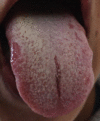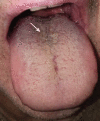Overview of common oral lesions
- PMID: 36606178
- PMCID: PMC9809440
- DOI: 10.51866/rv.37
Overview of common oral lesions
Abstract
This article summarises common oral lesions that clinicians may face in everyday practice by categorising them by clinical presentation: ulcerated lesions, white or mixed white-red lesions, lumps and bumps, and pigmented lesions. The pathologies covered include recurrent aphthous stomatitis, herpes simplex virus, oral squamous cell carcinoma, geographic tongue, oral candidosis, oral lichen planus, pre-malignant disorders, pyogenic granuloma, mucocele and squamous cell papilloma, oral melanoma, hairy tongue and amalgam tattoo. The objective of this review is to improve clinician knowledge and confidence in assessing and managing common oral lesions presenting in the primary care setting.
Keywords: Dentistry; Oral lesions; Oral medicine; Primary health care.
© Academy of Family Physicians of Malaysia.
Figures





























References
Publication types
LinkOut - more resources
Full Text Sources
